The Mythical Weapons of Persian Heroes
1. Introduction
Persian mythology, with its rich tapestry of heroes, gods, and fantastical creatures, has captivated audiences for centuries. These stories not only entertain but also offer insights into the cultural values, beliefs, and aspirations of the Persian people. Among the many elements that make these tales so compelling are the mythical weapons wielded by the heroes, each imbued with unique powers and significance. These weapons are not mere tools of combat; they are symbols of power, courage, and divine intervention.
2. Rostam's Dastan
Rostam, a towering figure in Persian mythology, embodies the ideal hero: brave, strong, and unwavering in his loyalty to king and country. His epic tale, Rostam's Dastan, narrates his extraordinary life and adventures, showcasing his unparalleled skill in battle and his unwavering commitment to justice. The weapons he wields are legendary, each possessing a mystical aura that enhances his heroic stature.
3. Zahhak's Serpent Daggers
In stark contrast to the heroic Rostam stands Zahhak, a tyrannical king whose reign is marked by cruelty and oppression. His origin story is shrouded in darkness, linked to a pact with the devil that condemned him to bear serpent daggers growing from his shoulders. These daggers symbolize the corrupting influence of evil and the suffering it inflicts upon both the ruler and the ruled.
4. The Simurgh's Feather
The Simurgh, a benevolent mythical bird, plays a pivotal role in the lives of several Persian heroes, including Zal and Rostam. This majestic creature, reminiscent of the phoenix, represents wisdom, guidance, and protection. The feather it bestows upon its chosen champions serves as a tangible reminder of its unwavering support and a symbol of their connection to the divine realm.
5. The Avestan Mace
Beyond the realm of epic poems and legendary heroes, the Avestan mace stands as a potent symbol of divine power and cosmic battles. Referenced in Zoroastrian texts, this mighty weapon is associated with the god Mithra, who embodies justice and cosmic order. The Avestan mace represents the eternal struggle between good and evil and the triumph of light over darkness.
6. Kay Khosrow's Jeweled Sword
Kay Khosrow, a legendary figure in Persian mythology, is renowned for his wisdom and just rule as the King of Persia. The jeweled sword he wields is a potent symbol of his authority and power, representing not only his control over the realm but also his unwavering commitment to uphold justice and protect his subjects. The jewels adorning the sword gleam with an otherworldly radiance, reflecting the king's wisdom and illuminating his path to righteous leadership.
7. The Shahnameh and the Significance of Weapons
The Shahnameh, a vast and magnificent collection of epic poems, stands as the cornerstone of Persian literature. Composed by the celebrated poet Ferdowsi, it chronicles the history and mythology of Persia, weaving tales of legendary heroes, valiant battles, and fantastical creatures. Weapons play a prominent role in the Shahnameh, serving not only as instruments of war but as symbols of power, courage, and divine intervention. Through the heroes' masterful wielding of these mythical weapons, the Shahnameh extols the values of valor, righteousness, and unwavering loyalty that have shaped the Persian identity for centuries.
8. The Symbolism and Significance of Mythical Weapons
The mythical weapons found in Persian mythology hold deep symbolic significance, reflecting the values, beliefs, and aspirations of the Persian people. These weapons transcend their mere physical form, embodying ideals such as courage, justice, and divine intervention. They are testaments to the Persian belief in the interconnectedness of the mortal and divine realms, where heroes are guided and empowered by forces beyond human comprehension.
9. The Enduring Legacy of Persian Mythical Weapons
The mythical weapons of Persian heroes have left an indelible mark on the cultural landscape of Persia and beyond. Their stories continue to inspire and captivate audiences across generations, reminding us of the enduring human quest for justice, righteousness, and courage in the face of adversity. These weapons serve as reminders of the power of imagination and storytelling, their legendary status a testament to the enduring legacy of Persian mythology.
10. The Cultural Impact of Persian Mythical Weapons
The influence of Persian mythical weapons extends far beyond the realm of mythology. These powerful symbols have permeated various aspects of Persian culture, including art, literature, architecture, and even everyday life. Their presence can be seen in intricate carvings on ancient palaces, in the evocative verses of Persian poetry, and in the symbolic motifs adorning traditional Persian carpets. The enduring legacy of these mythical weapons continues to shape the cultural identity of Persia, reminding us of the profound impact of storytelling and its ability to inspire generations.
FAQ
What are some of the most famous mythical weapons in Persian mythology?
- Rostam's Gorz-e Rostam (mace)
- Rostam's Rakhsh (horse)
- Rostam's Tigh-e Rostam (bow and arrows)
- Zahhak's serpent daggers
- The Simurgh's feather
- Kay Khosrow's jeweled sword
What is the significance of mythical weapons in Persian mythology?
Mythical weapons in Persian mythology serve as symbols of power, courage, divine intervention, and the interconnectedness of the mortal and divine realms. They embody the values and aspirations of the Persian people and reflect their belief in the triumph of good over evil.
What is the cultural impact of Persian mythical weapons?
Persian mythical weapons have had a profound impact on Persian culture, influencing art, literature, architecture, and even everyday life. Their enduring legacy continues to inspire and shape the cultural identity of Persia, reminding us of the power of storytelling and its ability to transcend generations.



